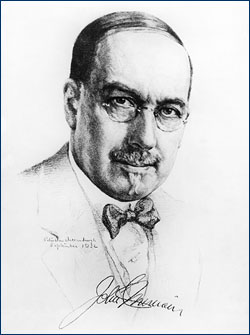John C. Merriam (1869-1945)
 |
|
|
|
 |
After 1920, Merriam's output of original research decreased as his administrative duties expanded. However, he oversaw and encouraged paleontological research, established a seismological research program in conjunction with the California Institute of Technology, helped develop the educational features of the U.S. National Parks, became active in conservation issues of his time such as the preservation of the Pacific Coast redwoods, and accomplished many other things as president of the Carnegie Institute. During this time, and especially after his retirement as president in 1938, his interests turned to the place of science in human thought and human values. He expounded his philosophy of science in two books, The Living Past and The Garment of God, as well as in many articles and addresses.
Merriam's views of evolution were progressionist, much more so than the views of most evolutionary biologists today. Evolution, for Merriam, represented an increase in efficiency and complexity. But Merriam was not interested so much in evolution itself as in the perspective that an understanding and appreciation of the natural world — whether based on science, art, or pure aesthetics — could bring to human life. Central to this perspective was an understanding of evolution and evolutionary time. Far from making the universe a chaotic and impersonal place, as had been argued (and still is being argued) by critics of evolution, an understanding of evolution can actually help us to perceive order, meaning, and laws in the universe. In The Garment of God, published in 1943, Merriam emphasized the importance of evolution:
"But there is reason to believe that of concepts in science arising from study of nature, there are none that would be considered to have influenced our belief more deeply than the generalized principles concerning development or evolution, reaching through vast ages in the story of the earth, and leading ultimately to advance in human life and institutions. As an outgrowth of the view of nature seen today...there is strong evidence that this vision of life development affecting us so deeply tends to transmute itself ultimately into emphasis on what we call progress.... As result of this situation one notes that in studying the universe widely in space, and deeply in time, out of our developing experience there tends to grow an attitude toward life that gives perspective instead of formless space, order in the place of aimless movement, confidence in the dependability of the universe and its laws, and faith that the world is so constructed as to maintain the trend of its development or evolutionary progress. Such an attitude towards this world and its meaning is enormously important to us when, as now, complicated dangers and evils seem almost to overwhelm us."
Merriam believed that such an evolutionary worldview, if it were to be of use to humanity, could not be restricted to an awareness of past events; it had to include their interconnectedness: "One sees the mechanism of nature and of history as if with all its parts in operation, and compasses the great complex in a single sweep of vision. As this abyss of time cuts down across the ages, it presents in clear perspective of one great picture the reality, the sequence, and the movement in a vast tide of events. the beginnings do not appear, but upon the high walls enough is written to illustrate the processes of change, and to show us also that the end is not in view."
Such an understanding of geological and historical change as a dynamic process, to Merriam, would be crucial for the future development of the human species. In a speech given in 1933, entitled "Time and Change in History," Merriam summed up his vision of time and its relevance for humankind, in words that are as meaningful now as they were over sixty years ago:
"The greatest value coming from our vision of change and time and their consequences is the idea that the world moves and that what we do is important for coming generations. This will be true whether we build for the future, or reduce our opportunity by degenerative or destructive pleasures which waste the store of materials that the past has accumulated."
REFERENCES
Merriam, J.C. 1911. The fauna of Rancho La Brea. Part I: Occurrence.
Memoirs of the University of California 1(2): 197-213.
Merriam, J.C. 1943. The Garment of God: Influence of Nature in Human
Experience. New York: Charles Scribner's Sons.
Stock, C. 1946. John Campbell Merriam, 1869-1945. Science
103: 470-471.